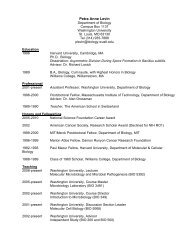Nikon A1Si Laser Scanning Confocal Microscope - Biology ...
Nikon A1Si Laser Scanning Confocal Microscope - Biology ...
Nikon A1Si Laser Scanning Confocal Microscope - Biology ...
Create successful ePaper yourself
Turn your PDF publications into a flip-book with our unique Google optimized e-Paper software.
<strong>Nikon</strong> <strong>A1Si</strong> <strong>Laser</strong> <strong>Scanning</strong> <strong>Confocal</strong> <strong>Microscope</strong><br />
<strong>Confocal</strong> microscopy uses optical methods to remove the out-of-focus blur of fluorescence microscopy<br />
images. In widefield microscopy, not only is the plane of focus illuminated but also much of the specimen<br />
above and below this point, resulting in out-of-focus blur from these areas. This out-of-focus light leads to<br />
a reduction in image contrast and a decrease in resolution by obscuring important structures of interest,<br />
particularly in thick specimens.<br />
Figure 1. Principals of LSCM confocal<br />
microscopy. From <strong>Nikon</strong> Microscopy U<br />
For more information about confocal microscopy, visit <strong>Nikon</strong> MicroscopyU at:<br />
http://www.microscopyu.com/articles/confocal/index.html<br />
In the confocal microscope most of the out-of-focus<br />
structures are suppressed at image formation. This is<br />
obtained by an arrangement of diaphragms, which<br />
conjugate points of the path of rays, act as a point<br />
source and as a point detector respectively. The<br />
detection pinhole does not permit rays of light from<br />
out-of-focus points to pass through it (Figure 1).<br />
In the <strong>Laser</strong> <strong>Scanning</strong> <strong>Confocal</strong> <strong>Microscope</strong> (LSCM) a<br />
single point of light is moved across the specimen by<br />
scanning mirrors and the image is built up pixel by<br />
pixel. The emitted/reflected light passing through the<br />
detector pinhole is transformed into electrical signals<br />
by a photomultiplier and displayed on a computer<br />
monitor. The confocal scanning microscope allows<br />
optical sectioning of samples up to 150 microns thick.<br />
If you are resolving thick samples or doing 3-D<br />
reconstruction, confocal is your first choice<br />
The <strong>Biology</strong> Department <strong>Nikon</strong> <strong>A1Si</strong> LSCM was installed in 2009. It offers many features for acquisition<br />
and analysis of high quality fluorescent and Differential Interference Contrast images. The <strong>A1Si</strong> features 4<br />
Melles Griot lasers ranging from 408 nm (near blue) to 640 nm (far red) that can either be imaged by<br />
separate dedicated photomultipliers to allow up to 5 channel imaging (4 fluorescent + 1 transmitted), or the<br />
lasers can instead be directed to a 32 channel spectral detector for analysis at 2.5, 6, or 10 nm intervals<br />
allowing spectral analysis of a sample over a wavelength range of up to 320 nm. In addition, the spectral<br />
detector output can be binned into up to 4 channels to allow fine-tuning of emission output for unusual<br />
fluorophores (Virtual Filtering). Regions of Interest (ROI’s) can be chosen from the full 32-channel output<br />
and unmixed into separate channels in real time so that even objects with very close emission maxima can<br />
be cleanly separated from one another (Spectral Unmixing). The 408 nm laser allows direct visualization<br />
of DAPI- stained samples for quick and accurate analysis of cell nuclear material, and can be used to bleach<br />
or activate ROI’s for FRAP or photoactivation analysis. The rapid and accurate Z motor allows for rapid<br />
3D acquisition in the Z plane and can easily be coupled to a time-lapse macro for 4D imaging. In addition,<br />
FRET, FLIP and colocalization studies can be performed. Finally, <strong>Nikon</strong>’s unique low-incident angle<br />
dichroics and hexagonal pinhole combine to allow much lower laser powers to be used for sensitive live<br />
imaging.
Figure 2: Spectral acquisition and spectral unmixing<br />
(from <strong>Nikon</strong> A1 website).<br />
Figure 3: 30% fluorescence intensity leads to lower<br />
laser powers. (<strong>Nikon</strong> A1 website).<br />
Figure 4: Virtual<br />
Filtering (<strong>Nikon</strong> A1<br />
website).
System Specifications<br />
• <strong>Microscope</strong> and illumination sources: <strong>Nikon</strong> Ti-E inverted microscope with DIC optics and PFS<br />
perfect focus stage controller. Broadband illumination withTl-PS100W halogen lamp illuminator<br />
and Intensilight C-HGFI precentered fiber optic mercury lamp fluorescent illuminator.<br />
• Objectives:<br />
Objective Magnification Working Distance Numerical Aperture<br />
CFI Plan Apo Dry 10X 4 mm 0.45<br />
CFI Plan Apo VC Dry 20X 1 mm 0.75<br />
CFI Plan FLUOR MI 20X 0.35 mm 0.75<br />
CFI Plan FLUOR Oil 40X 0.2 mm 1.30<br />
CFI Plan Apo VC Oil 60X 0.13 mm 1.4<br />
CFI Plan Apo VC Oil 100X 0.13 mm 1.4<br />
• <strong>Laser</strong>s: AOTF-modulated LU4A laser unit:<br />
<strong>Laser</strong> Wavelength Power<br />
Diode laser Melles/Griot 640 nm 10 mW<br />
DPSS laser Melles/Griot 561 nm 10 mW<br />
Argon-Ion laser Melles/Griot 457/488/514 nm 40 mW<br />
Diode laser Melles/Griot 408 nm 17 mW<br />
• Scanner: A1-SHS galvanometer scan head, Max 4096 X 4096 px resolution, Max scan speed of 4<br />
fps at 512 X 512 px resolution, 1-1000X continuously variable zoom, 8 position low-angle<br />
incidence dichroic mirrors, 12-256µm variable hexagonal pinhole<br />
• Detectors:<br />
2) Standard Detector: 4 PMT, 3 filter wheels allowing up to 6 filter cubes each:<br />
Filter Wheel Filter Cubes Installed<br />
Filter Wheel 1 450/50 480DCXR, 485/40 520DCXR<br />
Filter Wheel 2 525/50 560DCXR<br />
Filter Wheel 3 545/40, 600/50 640DCXR + 650LP<br />
2) Spectral Detector: 32 channel lambda detector. Max speed of 4 fps at 256 X 256 px resolution.<br />
Resolution: 80 nm at 2.5 nm step, 192 nm at 6 nm step, 320 nm at 10 nm step size. Real-time<br />
spectral unmixing; binning of up to 8 consecutive channels for virtual filtering.<br />
• Software: <strong>Nikon</strong> Elements software: 2D, 3D and 4D acquisition and object analysis, 3D volume<br />
rendering, Spectral Unmixing.<br />
• Applications: FRAP, FLIP, FRET, photoactivation, 3D timelapse, colocalization.<br />
• OS: Microsoft Windows 7 64-bit<br />
• Output: ND2, JPG200, JPG, TIFF, BMP, GIF, PNG, JFF, JTF, AVI, ICS/IDS
• Freeware: <strong>Nikon</strong> Elements NIS viewer software can be downloaded from the following URL:<br />
http://www.nis-elements.com/











